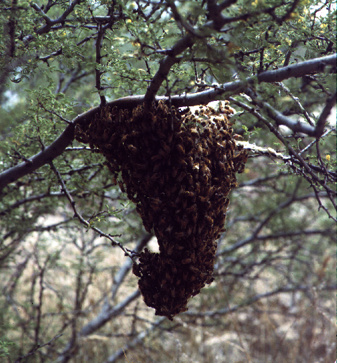Lesson 1.2
The Honey Bee's Home
Grades: K-3
Essential Skills: Science, Art
Duration: 1 class period
OVERVIEW
Students are introduced to the members and workings of a honey bee colony. They will
learn the four stages of insect development. At the end of the lesson students will be able
to describe the structure of comb, describe the day-to-day activities of honey bees, and
name the four stages of bee development.
Preparation
Teacher Preparation:
Curriculum Support Materials:
- Poster 3. Honey bee queen and workers on comb
- Poster 2. Honey bee swarm in a tree
- Plastic honeycomb
Other Materials:
- Real comb, if available or a demonstration hive
- Egg carton bottoms
- Construction paper - four different colors (for cells)
- Butcher paper (for three-dimensional cells)
- Scissors
Information Sheets:
Activity Sheets:
Lesson Plan
Introduction activity (20 minutes)
Read the studentS Mister Toad by C. Watson. Explain to them that honey bees live on a
wax structure called the comb or sometimes honeycomb. The comb is made up of six-sided
chambers called cells.
The easiest way to demonstrate the idea of a three-dimensional cell is to use a few egg
carton bottoms linked together. Tie in the idea of cells as rooms, so the comb becomes a
house full of tiny rooms. Explain that some of the rooms are where the baby bees develop,
and some of the rooms are where the food is made and kept.
Pass around the plastic honeycomb so the students can see how the cells are linked to
gether. Show real honeycomb, if available.
AHB Note: Africanized honey bees build slightly smaller cells on average than European honey
bees. This is why Africanized honey bees can produce more worker bees in the same amount of
space.
Activity 2 Making cells and a comb (30 minutes)
Randomly assign students one of four colors of construction paper chosen to represent
eggs, larvae, pupae or honey. Give each student a cell pattern to use as a template and
have them cut out a cell from their paper and sign their name on it.
Have the students attach their polygons to some butcher paper or place together on a
bulletin board so that the sides are together properly. Arrange the cells so those containing
eggs, larvae and pupae are grouped together in the middle and those containing honey are
towards the outside.
Add depth to the cells by cutting a strip of paper the length of the outer margin of the cell
(six times the length of one side). Have the students fold the paper into six equal pieces
(five folds) and then tape the ends together. Fasten this hexagon to the flat construction
paper bottom.
Activity 3 Polygon shapes (15 minutes)
More advanced students can investigate which polygons will fit together most efficiently,
without space between them.
Have the students construct different polygons, such as triangles, squares, pentagons and
octagons, as well as some circles. Draw the cells illustrated in
Activity Sheet 18 (polygons and cell shapes) on the chalk board.
Have the students discuss why bees use six-sided cells, getting them to understand that
other cell shapes lead to wasted space between the cells. Explain that although three-sided
and four-sided cells fit together without space between, they have lots of corner space
inside that would be wasted with a round larva.
For PS, K: Larvae or cells of different sizes may be used to distinguish size sequences
(which is big, bigger or biggest). Students may also be asked about directions such as left,
right, up and down once cells are grouped.
Conclusion Living in a hive (30 minutes)
Have the students tell stories or act out what they think it would be like growing up and
living in a honey bee hive. Each child can tell what it might be like to be the stage of insect
he/she was assigned in Activity 2.
Suggest that all the bees grow up and the hive becomes too crowded so they rear a new
queen. The old queen flies away with half the workers to start a new home. Show Poster 2
of a swarm. Have several students act as scout bees and look for a new place to live. They
can then come back and lead the "swarm" to their new home.

Swarm of Honey Bees
AHB Note: Africanized honey bees are known to build their nests in a wider variety of locations
than other honey bees. They may set up nests in water valve boxes or in animal burrows. If
students see a honey bee colony they should treat it as if it were Africanized and STAY AWAY
FROM IT!
Additions
Extensions:
- Have the students color
Activity Sheet 5. Discuss all the locations where bees may
live.
- Ask a beekeeper to visit the class.
Words with special meanings:
(for understanding only, not to be tested)
- Honeycomb
- Cell
- Egg(s)
- Larva(e)
- Pupa(e)
- Swarm
- Polygon
Bibliography:
Buzzing A Hive, by Jean Echols, illustrated by Lisa Haderlie Baker. Published by Great Explora
tions in Math and Science, Lawerence Hall of Science, Unversity of California,
Berkeley, 1987.
Animal Architecture, by K. von Frisch. Published by Harcourt Brace Javonovich, 1971.
Shapes, Shapes, Shapes, by T. Hoban. Published by Greenwillow Books, N.Y., 1986.
A House is a House for Me, by M.A. Hoberman. Published by Viking Press, N.Y., 1978.
Mister Toad, by C. Watson. Published by MacMillan, N.Y., 1992.
